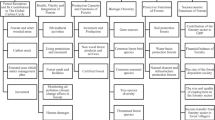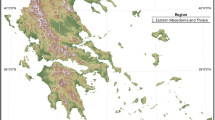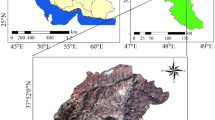Abstract
The main aim of this research was to quantify the parameters related to forest situation (according to DPSIR framework) using decision-making processes and fuzzy methods in the Zagros forests of Iran. In this study, the situation factors (e.g., socioeconomic, biophysical, and environmental factors) were evaluated by fuzzy analytic hierarchy process (FAHP) using \(\alpha\)-cuts in addition to the Chang method for fuzzy pairwise comparisons. The results of the study clearly illustrate that the decision-making process is the most important input in forest management planning in the Zagros forests, Iran. In such situations, decision-making techniques can be of great help in differentiating the factors influencing decision-making and policy-making for these forests. We found that \(\alpha\)-cuts could improve the quality of the decision-making process, but only after secondary analysis. Initially, we did not find any significant difference in the results between \(\alpha\)-cuts and research results, but using the differences in rankings, we could identify a significant difference. We propose that this method, which requires lengthy calculations to get the answer, should only be used by forest managers when the quality of the results and the difference between the parameters are very important to them; otherwise, they may be able to achieve the same desired results in a much easier way.





Similar content being viewed by others
Data availability
For further information, please contact the corresponding author (mehdi.zandebasiri@yahoo.com).
Abbreviations
- AHP:
-
Analytic hierarchy process
- DPSIR:
-
Driving forces, pressures, state, impact, responses
- FMP:
-
Forest management plan
- FSE:
-
Fuzzy synthetic extent
- MCDM:
-
Multi criteria decision making
- SWOT:
-
Strengths, weaknesses, opportunities, threats
- ANP:
-
Analytic network process
- FAHP:
-
Fuzzy analytic hierarchy process
- FMU:
-
Forest management unit
- MADM:
-
Multi attribute decision making
- NGOs:
-
Non-governmental organizations
- TFN:
-
Triangular fuzzy number
References
Abbasi Shureshjani, R. A, & Darehmiraki, M. (2013). A new parametric method for ranking fuzzy numbers. Indagationes Mathematicae, 24, 518–529. https://doi.org/10.1016/j.indag.2013.02.002
Ananda, J., & Herath, G. (2009). Multi-attribute preference modeling regional land-use planning. Ecological Economic, 65, 325–335. https://doi.org/10.1016/j.ecolecon.2007.06.024
Ataei, M. (2016). Fuzzy multi criteria decision making, Shahroud University of Technology Publication, 264 p. (In Persian).
Basirzadeh, H., & Abbasi Shureshjani , R. (2008). A new approach for ranking fuzzy numbers based on cuts. Journal of Applied Mathematics and Informatics, 26, 767–778.
Bojadziev, G., & Bojadziev, M. (2007). Fuzzy logic for business, finance, and management (2nd ed.). World Scientific, Translated by Seyed Mohammadreza Hoseini, Ishigh Publication in Persian.
Cooper, P. (2012). The DPSWR social ecological accounting framework; notes on its definition and application. School of Management University of Bath. Bath BA27AY.
Chang, D. Y. (1996). Applications of the extent analysis method on fuzzy AHP. European Journal of Operational Research, 95(3), 649–655.
Danehkar, A. & Zandebasiri, M. (2020). System analysis in environment. Tehran University Press (In persian).
Ebrahimi Rostaghi, M., (2005). The role of policy-making and decision-making in protection of outside North forests. In Proceedings of the Conference on Protection of Forests in Sustainable Forest Management, Tehran, Iran, 11–13 October 2004; Published 2005 by Iranian society of forestry, Tehran, Iran, pp. 137–151.
EEA. (2003). Environmental indicators: Typology and use in reporting. European Environment Agency, 20 pp.
Erensal, Y. C., Oncan, T., & Demircan, M. L. (2006). Determining key capabilities in technology management using fuzzy analytic hierarchy process: A case study of Turkey. Information Sciences, 176, 2755–2770. https://doi.org/10.1016/j.ins.2005.11004
Ghazanfari, H., Namiranian, M., Sobhani, H., & Mohajer, R. M. (2004). Traditional forest management and its application to encourage public participation for sustainable forest management in the northern Zagros mountain of Kurdistan province, Iran. Scandinavian Journal of Forest Research, 19(4), 65–71. https://doi.org/10.1080/14004080410034074
Grošelj, P., Hodges, D. G., & Zadnik Stirn, L. (2016). Participatory and multi-criteria analysis for forest (ecosystem) management: A case study of Pohorje, Slovenia. Forest Policy and Economics, 71, 80–86. https://doi.org/10.1016/j.forpol.2015.05.006
Groselj, P., & Zadnik Stirn, L. (2018). Evaluation of several approaches for deriving weights in fuzzy group analytic hierarchy process. Journal of Decision Systems, 27(supl 1), 217–226. https://doi.org/10.1080/12460125.2018.1460160
Hemmati-Marbini, A., Emrouznejad, A., & Tavana, M. (2011). A taxonomy and review of the fuzzy data envelopment analysis literature: Two decades in the making. European Journal of Operational Research, 214(3), 457–472. https://doi.org/10.1016/j.ejor.2011.02.001
Heidari, M., Lotfalian, M., Tashakori, M., & Valipour, A. (2016). Investigating the local utilizationof forest in north Zagros (Case study: Baneh region). Iranian Journal of Forest, 8(3), 313–331. (In Persian with Abstract English).
Jabbour, J., & Hunsberger, C. (2014). Visualizing Relationships between Drivers of Environmental Change and Pressures on Land-Based Ecosystems. Natural Resources, 5, 146–160. https://doi.org/10.4236/nr.2014.54015
Jazirehi, M. H., & Ebrahimi Rostaghi, M. (2013). Silviculture in Zagros, Tehran University Press, (In Persian).
Kangas, J., & Kangas, A. (2005). Multiple criteria decision support in forest management – Fundamentals of the approach, methods applied, and experiences gained. Forest Ecology and Management, 207, 133–143. https://doi.org/10.1016/j.foreco.2004.10.023
Kangas, A., Korhonen, K. T., Packalen, T., & Vauhkonen, J. (2018). Sources and types of uncertainties in the information on forest-related ecosystem services. Forest Ecology and Management, 427, 7–16. https://doi.org/10.1016/j.foreco.2018.05.056
Kurttila, M., Pesonen, M., Kangas, J., & Kajanus, M. (2000). Utilizing the analytic hierarchy process (AHP) in SWOT analysis- a hybrid method and its application to a forest-certification case. Forest Policy and Economics, 1, 41–52. https://doi.org/10.1016/S1389-9341(99)00004-0
Mendoza, G. A., & Prabhu, R. (2003). Fuzzy methods for assessing criteria and indicators of sustainable forest management. Eclogical Indicators, 3, 227–236. https://doi.org/10.1016/j.ecolind.2003.08.001
Merwe, L. J., Samways, M. J., & Pryke, J. S. (2020). A new protocol for monitoring operational outcomes of environmental management in commercial forestry plantations. Journal of Environmental Management, 271, 110922. https://doi.org/10.1016/j.jenvman.2020.110922
Mohammadizadeh, M. J., Karbassi, A. R., Nabi Bidhendi, G. R., & Abbaspour, M. (2016). Integrated environmental management model of air pollution control by hybrid model of DPSIR and FAHP. Global Journal of Environmental Science and Management, 2(4): 381–388. https://doi.org/10.22034/GJESM.2016.02.04.007
Pourabdollah, A., Mendel, J. M., & John, R. I. (2020). Alpha-cut representation used for defuzzification in rule-based systems. Information Science, 399, 110–132. https://doi.org/10.1016/j.fss.2020.05.008
Pourhashemi, M., Zandebasiri, M., & Panahi, P. (2015). Structural characteristics of oak coppice stands of Marivan Forests. Journal of Plant Researches, 27(5), 766–776. (In Persian).
Imani Rastabi, M., Jalilvand, H., & Zandebasiri, M. (2015). Assessment of socio-economic criteria and indicators in monitoring of Kalgachi Lordegan forest management plan. Iranian Journal of Forest and Poplar Research, 23(2), 1–8. (In Persian with abstract English).
Scriban, R. E., Nichiforel, L., Gianina, L., Barnoaiea, L. G., Cosofret, V. C., & Barbu, C. O. (2019). Governance of the forest restitution process in Romania: An application of the DPSIR model. Forest Policy and Economics, 99, 59–67. https://doi.org/10.1016/j.forpol.2017.10.018
Shakouri, B., Abbasi Shureshjani, R., Daneshian, B., & Hosseinzadeh Lotf, F. (2020). A parametric method for ranking intuitionistic fuzzy numbers and its application to solve intuitionistic fuzzy network data envelopment analysis models. Complexity, 6408613.
Vacik, H., Zlatanov, T., Trajkov, P., & Dekanic, S. (2009). Role of coppice forests in maintaining forest biodiversity. Silva Balcanica, 10(1), 35–45.
Valipour, A., Plieninger, T., Shakeri, Z., Ghazanfari, H., Namiranian, M., & Lexer, M. J. (2014). Traditional silvopastoral management and its effects on forest stand structure in northern Zagros, Iran. Forest Ecology and Management, 327, 221–230. https://doi.org/10.1016/j.foreco.2014.05.004
Wang, T. C., & Chen, Y. H. (2007). Applying consistent fuzzy preference relations to partnership selection. Omega, 35, 384–388.
Wang, Y. -M., Luo, Y., & Hua, Z. (2008). On the extent analysis method for fuzzy AHP and its applications. European Journal of Operational Research, 186(2), 735–747.
Wolfslehner, B., & Vacik, H. (2008). Evaluating sustainable forest management strategies with the Analytic Network Process in a Pressure-State-Response framework. Journal of Environmental Management, 88(1), 1–10. https://doi.org/10.1016/j.jenvman.2007.01.027
Zadeh, L. A. (1971). Similarity relations and fuzzy orderings. Information Sciences, 3(2), 177–200.
Zaerpour, N., Rabbani, M., Gharehgozli, A. H., & Tavakkoli-Moghaddam, R. (2008). Make-to-order or make-to-stock decision by a novel hybrid approach. Advanced Engineering Informatics, 22(2), 186–201. https://doi.org/10.1016/j.aei.2007.10.002
Zandebasiri, M., & Ghazanfari, H. (2010). The main consequences affecting factors on forest management local settlers in the Zagros forests (case study: Ghalegol watershed in Lorestan province). Iranian Journal of Forest, 2(2), 127–138. (In Persian with English abstract).
Zandebasiri, M., Ghazanfari, H., Sepahvand, A., & Fatehi, P. (2011). Presentation of decision making pattern for Forest management Unit under uncertainty conditions (case study: Taf local area-Lorestan). Iranian Journal of Forest, 3(2), 109–120. (In Persian with English abstract).
Zandebasiri, M., Ghazanfari, H., Abbasi, R., & Sayad, E. (2012). The use of fuzzy pairwise comparisons to determine the most important factors of forest management plans in Iran. Scholarly Journal of Agricultural Science, 2(9), 217–223.
Zandebasiri, M., & Pourhashemi, M. (2016). The place of AHP among the Multi criteria decision making methods in forest management. International Journal of Applied Operational Research, 6(2), 75–89.
Zandebasiri, M., Soosani, J., & Pourhashemi, M. (2017a). Evaluation of natural and social problems with DPSIR framework in Zagros forests decline, Iran. Bioscience, Biotechnology, Research Communication, 10(2), 58–62. https://doi.org/10.21786/bbrc/10.2/10
Zandebasiri, M., Soosani, J., & Pourhashemi, M. (2017b). Evaluation of sustainable forest Management of Iran’s Zagros forests. Journal of Applied Science and Environmental Management, 21(5), 811–815. https://doi.org/10.4314/jasem.v21i5.3
Zandebasiri, M., Soosani, J., & Pourhashemi, M. (2017c). Evaluation of the crisis severity in forests of Kohgiluye and Boyerahmad province (Case study: Tange Solak). Iranian Journal of Forest and Poplar Research, 24(4), 665–674. (In Persian with English abstract) https://doi.org/10.22092/IJFPR.2016.109445
Zandebasiri, M., Vacik, H., Etongo, D., Dorfstetter, Y., Soosani, J., & Pourhashemi, M. (2019). Application of time-cost trade-off model in forest management projects. Journal of Forest Science, 65(12), 481–492. https://doi.org/10.17221/65/2019-JFS
Zandebasiri, M., & Hoseini, S. M. (2019). Sustainable Forest Management (SFM). Jahad Daneshgahi Press (Mazandaran Branch), Sari, Iran, (In Persian).
Zandebasiri, M., & Pourhashemi, M. (2019). Traditional forest-related knowledge, Part 5: Silvopasture system. Iranian Journal of Nature, 3(6), 14–17.
Zandebasiri, M., Filipe, J. A., Soosani, J., Pourhashemi, M., Salvati, L., Mata, M. N., & Mata, P. N. (2020a). An incomplete information static game evaluating community-based forest management in Zagros. Iran. Sustainability, 12(1750), 1–14. https://doi.org/10.3390/su12051750
Zandebasiri, M., Soosani, J., & Pourhashemi, M. (2020b). Evaluating the necessary elements to introduce organizational agility pattern in Oak decline of the Zagros forests. Journal of Environmental Science and Technology, 22(1): 377- 390. (In Persian with English abstract). https://doi.org/10.2203/JEST.2018.2638103535
Zanjirche, S. M. (2015). Fuzzy analytic hierarchy process. Sanei Shahmirzadi Publication, 284 p. (In Persian).
Acknowledgements
Dr. Zandbassiri’s doctoral thesis at Lorestan University, Iran, focused on the issue of forest decline. This research, as an independent study, is outside of his doctoral thesis and focuses on quantifying the results of the strategies needed to reduce forest decline with fuzzy MCDM. We thank the experts who helped us in weighting the DPSIR factors and two anonymous reviewers as well for their helpful comments. Petra Grošelj also acknowledges the financial support of the Slovenian Research Agency (research core funding No. P4-0059).
Author information
Authors and Affiliations
Corresponding author
Ethics declarations
Competing interests
The authors declare no competing interests.
Additional information
Publisher's Note
Springer Nature remains neutral with regard to jurisdictional claims in published maps and institutional affiliations.
Appendix
Appendix
Livestock grazing in the forest is one of the problems of Zagros forests in Iran. This issue causes both soil weakness and the elimination of sexual reproduction in the forest. Nowadays, the Zagros forests of Iran are mainly coppice forests (such as show in Fig. 6). Coppice forests can reduce the tree species richness (Vacik et al., 2009), but the problem in the Zagros forest is that the possibility of turning these forests into high forests is low due to socioeconomic problems (Ghazanfari et al., 2004; Valipour et al., 2014; Imani Rastabi et al., 2015). In some areas, there is a combination of coppice with standard tree species richness, but many single stems are the oldest shoots of the past.
One of the visible conditions in the Zagros forests is rock outcrops and soil erosion. In some cases, the ground is barely covered by forest trees and there are many pebbles on the ground of oak stands (such as shown in Fig. 7). This specifies the need for protection in such areas.
Soil weakness is the main impact of these pressures and drivers. In this paper, “soil weakness” consists of loss of microorganisms in soil (such as earthworm), lack of surface cover, and lack of stability. This impact involves weakness in various productions, lack of stability and environmental capabilities, and reducing social welfare which originated from the lack of soil productivity. This can be attributed to the importance of soil for seed regeneration, an issue that Zagros forests suffer from. The weakness of the soil can also be caused by the grazing of the cattle, the lack of crown cover, and the dryness of the air. For about 10 years, the decline of the oak has been an issue. The rise in temperature, climate change, external dusts, and the general weakness of the forest structure could be the reason for this. After declining at the tree crowns, the basal emergence hole appears on oak trunks (Fig. 8).
Rights and permissions
About this article
Cite this article
Zandebasiri, M., Groselj, P., Azadi, H. et al. DPSIR framework priorities and its application to forest management: a fuzzy modeling. Environ Monit Assess 193, 598 (2021). https://doi.org/10.1007/s10661-021-09257-x
Received:
Accepted:
Published:
DOI: https://doi.org/10.1007/s10661-021-09257-x







